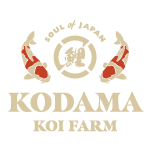Suzujyu Koi Farm
Characteristic features of his Showa lie in high quality Sumi and the Showa is very dynamic.
Learn More About Suzujyu Koi
Owner(s): Shigeo Suzuki
His father started Suzujyu Koi Farm in Jyunidaira, Ojiya-city which is famous for Showa breeding. Now, Mr. Shigeo Suzuki inherited the business. Of course, he breeds Showa. He does not breed a lot of Showa. He have only 30 Koi or or so at the age of 3 or older in one year. Therefore it is difficult to obtain his Showa and if you really want his Koi, you may need to reserve one through your dealer.
Interview with Suzujyu Koi Farm
Interview on May/June 2004
Suzujyu Koi Farm
by Mamoru Kodama
As most koi hobbyists know, koi are bred everywhere in Japan in places such as Niigata, Hiroshima, Kyushu area, and so forth. The most famous area is the Niigata prefecture. Niigata has about 650 breeders, and they breed beautiful koi. Probably Niigata is the only area that has this many breeders.
Every October, breeders have koi shows to compete with each other with their koi. The scores at the shows directly link to the rank as a breeder and influence the sales. The competition among breeders is quite severe.
Mr. Shigeo Suzuki at Suzujyu Koi Farm produces overwhelmingly strong koi in the baby class (25–35 cm 10–14in) at these koi shows. Today, I visited him at the Suzujyu Koi Farm.
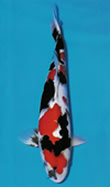
Kokugyo prize winner at the 15th All Japan Young Nishikigoi Show He breeds many top prize winners at top Koi shows. His Koi is popular for the high quality of white, black and red.
Kodama:
When did you start this koi business?
Suzuki:
My father started it.
Kodama:
Do you remember when?
Suzuki:
It was 1955. He started it by buying and raising tosai, first. All the breeders at the time were not able to afford having parents in Niigata. We had to begin with buying fry from those who had already bred koi. Unlike what we call fry now, that is 0.7 cm (0.28in), those fry were about 0.2 cm (0.8in). There was a breeder called “Chuko” in my neighborhood at Jyunidaira. He was breeding very nice Showa. He sold us his fry for 10 yen each. 10 yen at the time was very expensive. But we purchased about 100–200 and raised them up to 18 cm (7.2in) by autumn. Then, we sold them to a koi wholesaler.
Kodama:
What made your father start koi?
Suzuki:
I am not quite sure. But my father was a rice farmer. Around 1955 when koi became very popular, it had been said that breeding koi is good for farmers. So farmers turned paddy fields into ponds to keep koi. We were one of them. As koi became popular, we gradually started koi. There are good paddy fields and bad paddy fields. The good paddy fields, we kept for farming rice. The bad paddy fields or small ones, we turned them to koi ponds. At the time, there was no such thing as an indoor facility for winter like now. We raised them from spring to autumn and sold them all then. We sold them to koi wholesalers like Miyaishi and Miyakoya in Ojiya city.
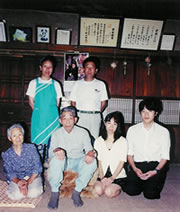
Family of Suzujyu Koi Farm
Kodama:
When did you start helping your father?
Suzuki:
Well, I think it was around 1966.
Kodama:
When did you start breeding?
Suzuki:
That is about when I joined the koi business. Since then, we gradually increased the volume of breeding.
Kodama:
You have been in the koi business for 38 years now. What is your policy to koi breeding.
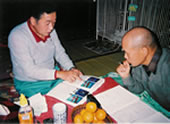
Mr. Suzuki explains the pairs of his parental Koi.
Suzuki:
It is theme (important) to me. I think koi is a creature whose beauty is to be appreciated. The campus for the art is a pond that each hobbyist has. When we look at ponds, the average size is 10–15 tons (2500–3750 gal), although some have ponds as large as 100 tons (25,000 gal) or even 150 tons (37,500 gal). So I think koi should be at appropriate size to stand out in these average-sized ponds. And I think 30–60 cm (12–24in) koi are the size for those ponds; 70–80 cm (28–32in) sized koi are too big for these ponds. After all, to appreciate koi’s beauty, we should consider the size of koi together with the size of the pond. This is why my koi are a little smaller. They are 30–35 cm (12–14in) at the age of two. Other breeders make them 40–45cm (16–18in) at the same age. Mine are smaller, but more beautiful than others. This year, too, I entered 10 koi at koi shows here and 6 of them won. I would like to breed “beautiful koi even if it is smaller” that please a lot of hobbyists rather than “grand champion koi”that please only a few hobbyists. So I think this is my theme and policy.
Kodama:
I see. I visit a lot of breeders at the harvesting season in autumn. But your koi finished most beautifully. Can you kindly share your secret?
Suzuki:
I think my breeding method is a little different. I think I am the only one who does this in Niigata. What I do is put the liner in the pond.
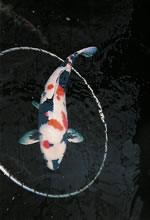
Female parent with pure white skin
Kodama:
You mean you use liners not only on the edges of the pond but also over the entire pond??
Suzuki:
Yes. I lay a large liner sheet for about a 5,326´ pond.
Kodama:
Interesting. So koi grow this beautiful in a liner pond?
Suzuki:
Yes. Niigata produces beautiful koi because of the “good clay quality.” This is true. But I think a liner pond is better to finish koi more beautifully.
Kodama:
I see. The hi gets enhanced more than in mud ponds.
Suzuki:
Only breeders enter koi in koi shows in Niigata. And I keep winning every year. I think this proves that my method makes koi more beautiful.
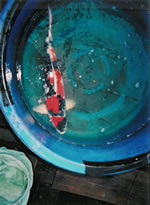
Male parent with deep red Hi quality
Kodama:
Many koi hobbyists keep koi in liner ponds. So this is a good way, isn’t this?
Suzuki:
From my many years of experience, it is a very good way.
Kodama:
How long have you used liner ponds?
Suzuki:
I believe it is more than 30 years.
Kodama:
Is that right? Who started this?
Suzuki:
There was a breeder called Mr. Harumitsu Shimomura in Ryuko, the next village. He passed away two years ago. He is the one who started it. Because his koi grow so beautifully, I learned it from him and started using this method.
Kodama:
It has been widely said “the reason why koi in Niigata are beautiful lies in its unique mud ponds. And the clay quality of mud ponds is suitable for koi.” Almost all the koi hobbyists in the world understand that koi are produced and raised in mud ponds of Niigata. I do not think they think breeders in Niigata use pond liners for the breeding.
Suzuki:
The job of koi breeders is to breed beautiful koi. Because I believe I can breed more beautiful koi in a liner pond than a mud pond, I have used the liner ponds for more than 30 years.
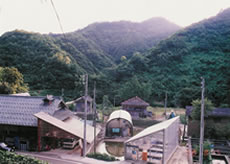
Suzujyu Koi Farm
Kodama:
A lot of koi hobbyists in the United States use a liner to build a pond. I think it is news that a Niigata breeder has used the liner since more than 30 years ago.
Suzuki:
Really? Do koi hobbyists in the United States keep koi in a liner pond?
Kodama:
Yes. Many hobbyists build their ponds by themselves. They dig a hole in the backyard and put the liner in it to keep koi.
Suzuki:
As a breeder, I keep using the liner pond for 30 years and believe that koi come out more beautiful than the mud ponds. So, if hobbyists in the United States use the liner, with confidence, I can say that it is a very good way to go.
Kodama:
How many tosai do you raise in the liner pond?
Suzuki:
About 2000. I put about 400 fry in each 5,326´ pond. I put them there in the spring and cull them in the summer from July to August. I put them back there and raise them until autumn. In the culling, I select 300 out of 400. This way, I can get more space for koi to grow big and I do not have to keep bad ones.
Kodama:
Then, you take the nice ones out of there to the koi shows in the autumn, don’t you. How did you do this year?
Suzuki:
I won 6 out of 10 entries. One got Baby Champion. So I think I did very well this year.
Kodama:
Do you think the liner breeding contributes to this result?
Suzuki:
Absolutely. Koi shows are the place to compete the beauty. All the breeders in Niigata raise koi to two years old and enter them in koi shows. The fact that my two-year-old do well at the shows means that I keep my koi somehow in a different way. My koi are more lustrous because I keep them in a liner pond. For the beauty competition, my method is better, after all.
Kodama:
Thank you for your time today.
We have koi available to buy from Suzujyu Koi Farm online if shown below the search field. If not, contact us with what you're looking for and we'll help find the right koi.
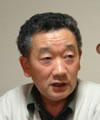
We couldn't find any products in our online store for your search in our Suzujyu Koi Farm catalog,
BUT we may have inventory at the farm or in Japan, so please use the "Request a Koi" form to help us find your perfect koi fish.
Koi Auctions Ending Soon!
Place your bids now to win your choice of beautiful Japanese koi for sale at a great price! We always have a variety of fixed price koi and consistently run koi auctions ending daily; with most special auctions ending on Wednesday and Sunday each week.
-
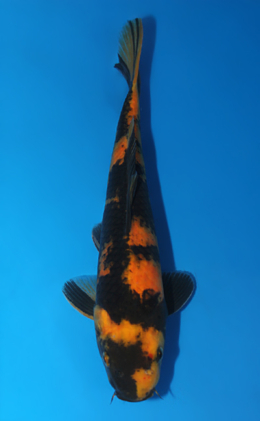
Ki Utsuri – koi #x0317a015
Current bid: $70.00Time left:Login / Register to BidHighest Bidder:KelticEstimated Value: $300.00Breeder(s): Otsuka Koi FarmSex: MaleBorn in: 2023Size: 12.20 inch / 31 cm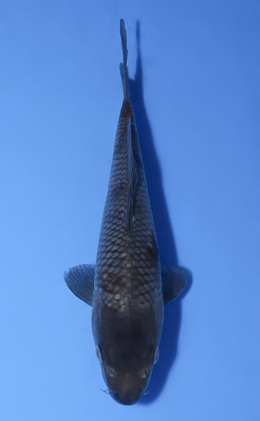
Ochiba Shigure – koi #x0514a005
Current bid: $20.00Time left:Login / Register to BidHighest Bidder:United KoiEstimated Value: $300.00Breeder(s): Kanno Koi FarmSex: UnknownBorn in: 2024Size: 7.09 inch / 18 cm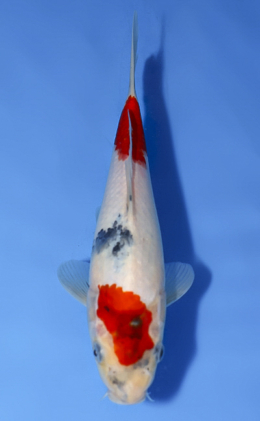
Showa – koi #x0514a009
Current bid: $10.00Time left:Login / Register to BidHighest Bidder:KelticEstimated Value: $300.00Breeder(s): Isa Koi FarmSex: UnknownBorn in: 2024Size: 7.87 inch / 20 cmVariety: Showa,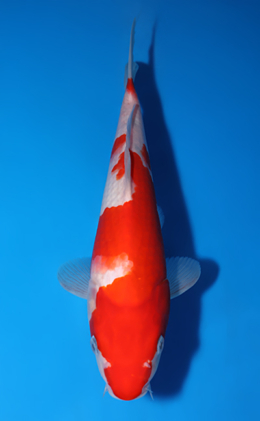
Kohaku – koi #x0519a051
Current bid: $10.00Time left:Login / Register to BidHighest Bidder:United KoiEstimated Value: $300.00Breeder(s): Dainichi Koi FarmSex: MaleBorn in: 2024Size: 10.24 inch / 26 cmVariety: Kohaku,A Variety of Koi Buying Options at Kodama Koi Farm
A Variety of Koi Buying Options at Kodama Koi Farm
Search All Koi Fish Online for Sale
Bid in Daily Koi Auctions
Submit Request for Your Dream Koi
Apply for Wholesale & Pond Pro Pricing
